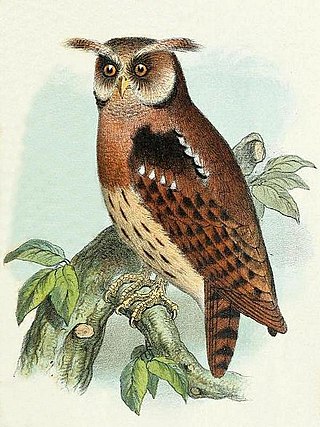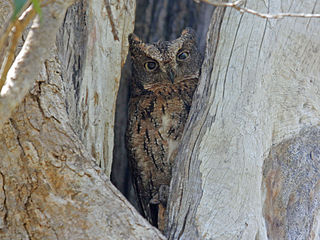
The collared scops owl is an owl which is a resident breeder in south Asia from northern Pakistan, northern India, Nepal, Bangladesh, the Himalayas east to south China, and Taiwan. It is partially migratory, with some birds wintering in India, Sri Lanka and Malaysia. This species was formerly considered to be included within what is now separated as the Indian scops owl.

The Philippine scops owl is a common owl, endemic to the Philippines, belonging to the family of the typical owls Strigidae. Other common names include "Otus Whitehead", "Whitehead scops owl" and "Luzon lowland scops owl". Everett's scops owl and Negros scops owls were formerly considered conspecific but are now classified as separate species.
The Karthala scops owl, also known as the Grand Comore scops owl or Comoro scops owl, is a small scops owl endemic to the island of Grande Comore in the Comoro Islands.
The Moheli scops owl is a scops owl endemic to the island of Mohéli, one of the Comoro Islands.
The Anjouan scops owl is an owl endemic to the island of Anjouan in the Comoro Islands.

The oriental scops owl is a species of scops owl found in eastern and southern Asia.

The African scops owl is a small owl which is widespread in sub-Saharan Africa.
The Javan scops owl is a small species of owl living mainly on western Java's high volcanos; local people refer to the owl as Celepuk Jawa. Like most owls, this nocturnal bird also has a strong ability of silent flight.

Wallace's scops owl is endemic to the Sumbawa and Flores islands, in the Lesser Sundas chain of Indonesia. It is not rare in most of its habitat and has no subspecies except for the nominate. It is also known as the Lesser Sunda scops owl. It is named after Alfred Russel Wallace, a British naturalist, explorer, geographer, and biologist.

The Mantanani scops owl, is a small owl in the scops-owl genus Otus found on small islands between Borneo and the Philippines. It is listed by the IUCN as "near threatened" because its range is limited with its population being fragmented on several different islands, and its forest habitat is being degraded by ongoing logging and clearance.

The black-throated coucal is a species of cuckoo in the family Cuculidae. It is found in West Africa in dense second growth along forest edge and grassy swamps. The subspecies found in northern and central Zaire is sometimes split as Neumann's coucal.

The African barred owlet is a species of small owl in the family Strigidae found in much of southern, central and eastern Africa. The taxon may be four species rather than a single species.

The red-chested owlet is a species of owl in the family Strigidae, native to the African tropical rainforest. Its habits and behaviour are poorly known.

The maned owl or the Akun scops owl, is a species of owl in the family Strigidae that is endemic to Africa. It is the only species in genus Jubula.

The São Tomé scops owl is a species of owl in the true owl family, Strigidae. It is endemic to São Tomé Island, part of São Tomé and Príncipe, in the Gulf of Guinea, off the western equatorial coast of Central Africa.

The Mayotte scops owl is a species of owl in the family Strigidae. It is endemic to the island of Mayotte in the Comoros.

The Pemba scops owl is a species of owl in the family Strigidae. It is endemic to Pemba Island which is part of and off the coast of Tanzania.

The Madagascar scops owl, also known as the Malagasy scops owl or Rainforest scops owl, is a species of owl in the family Strigidae. It is found throughout Madagascar, now that is has recently been lumped with the Torotoroka scops owl, with which it was long considered a separate species from. The nominate O. r. rutilus is referred to as Rainforest scops owl.

The Socotra scops owl is a small owl endemic to the island of Socotra, Yemen.

The Negros scops owl, also known as the Visayan scops owl, is an owl, endemic to the islands of Negros and Panay in the Philippines, belonging to the family of the typical owls Strigidae. It was formerly classified as a subspecies of the Philippine scops owl. It is threatened by habitat loss and hunting for the pet trade.

















